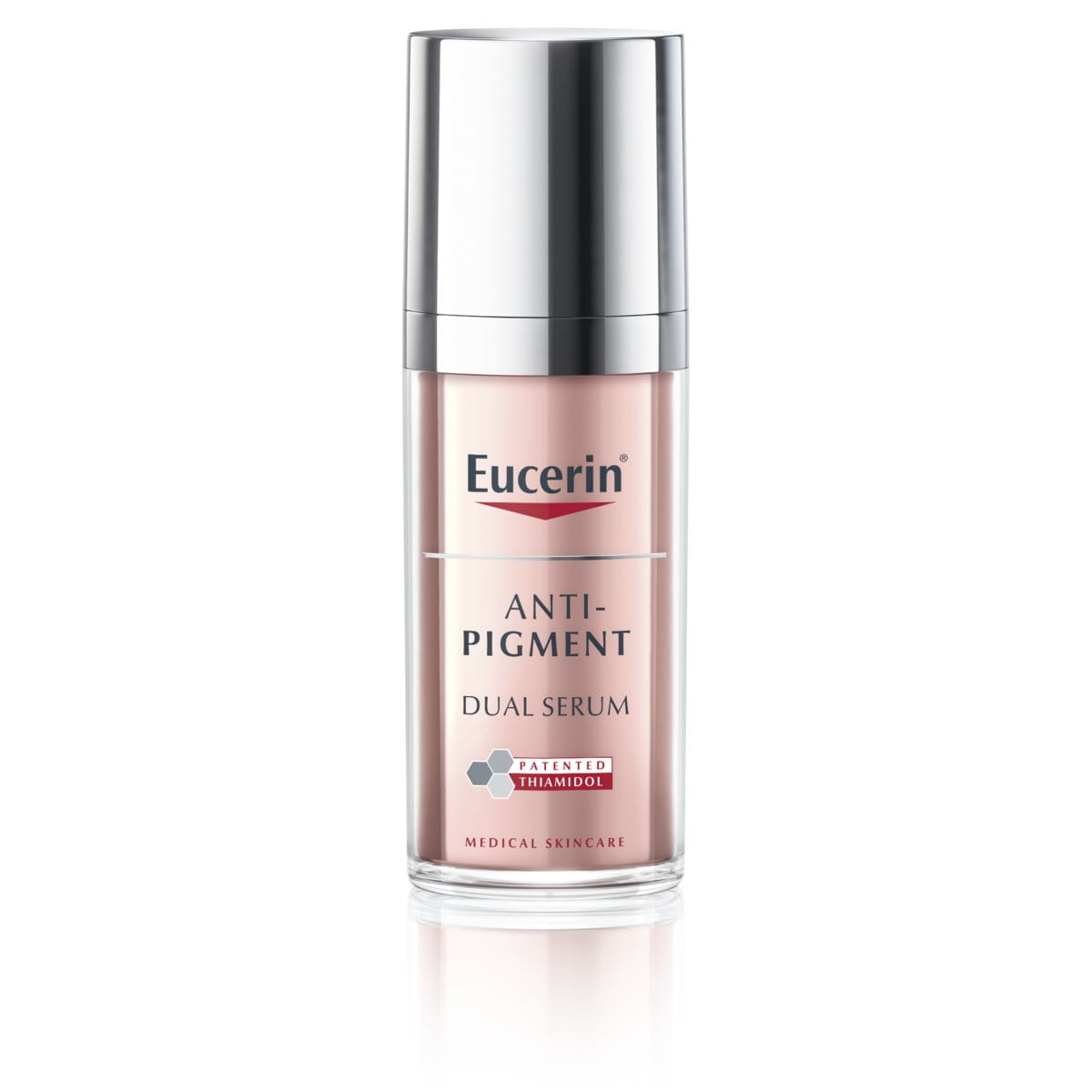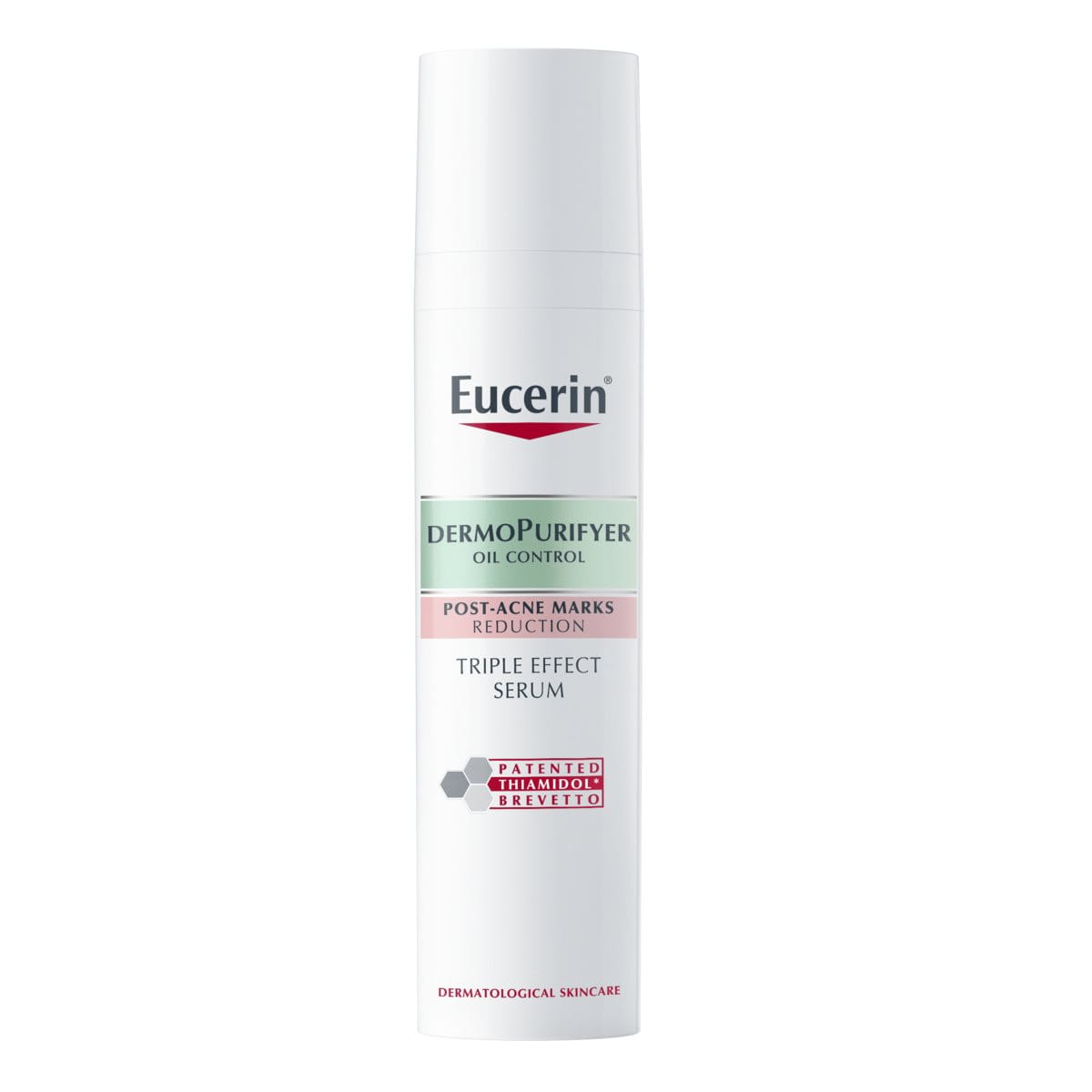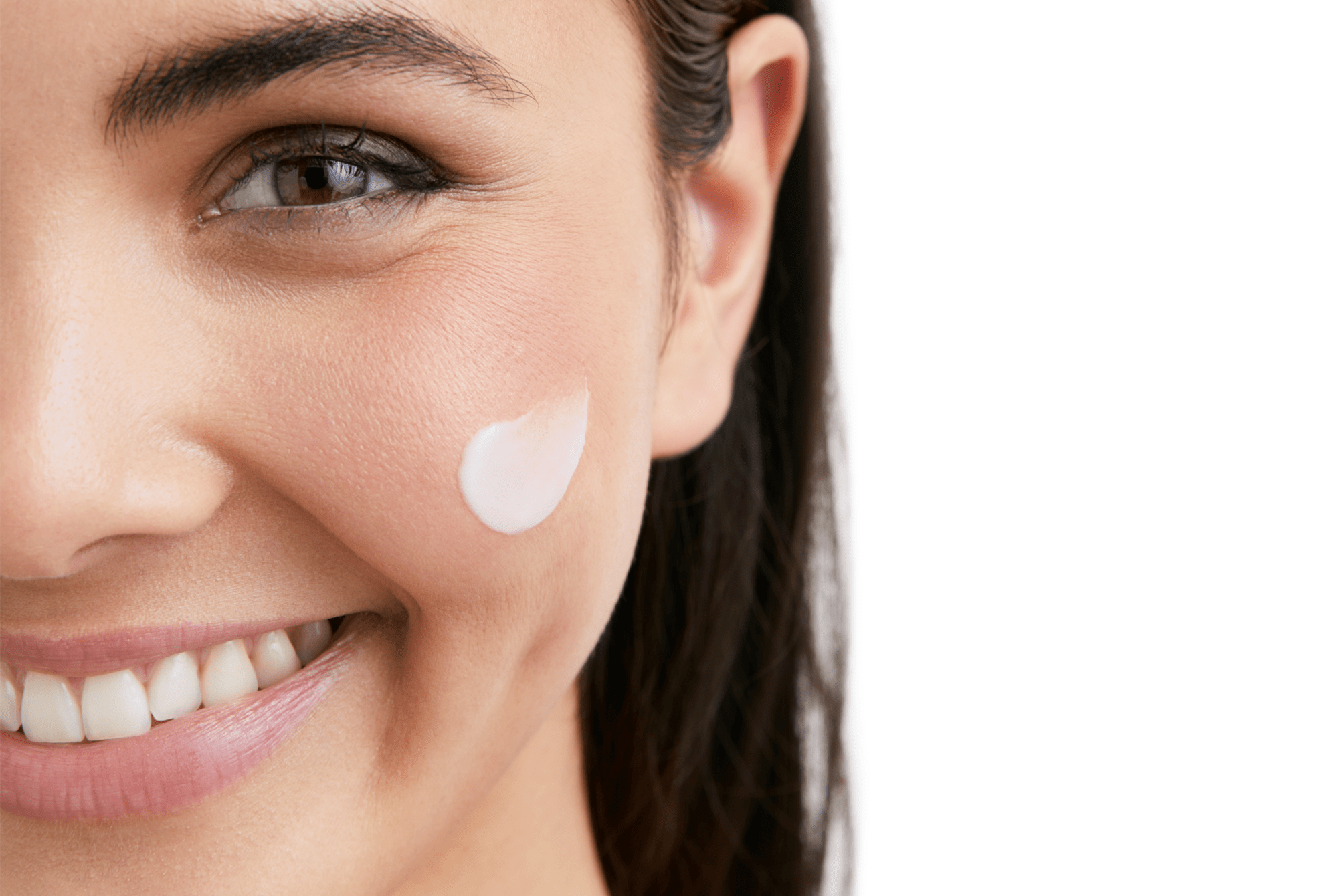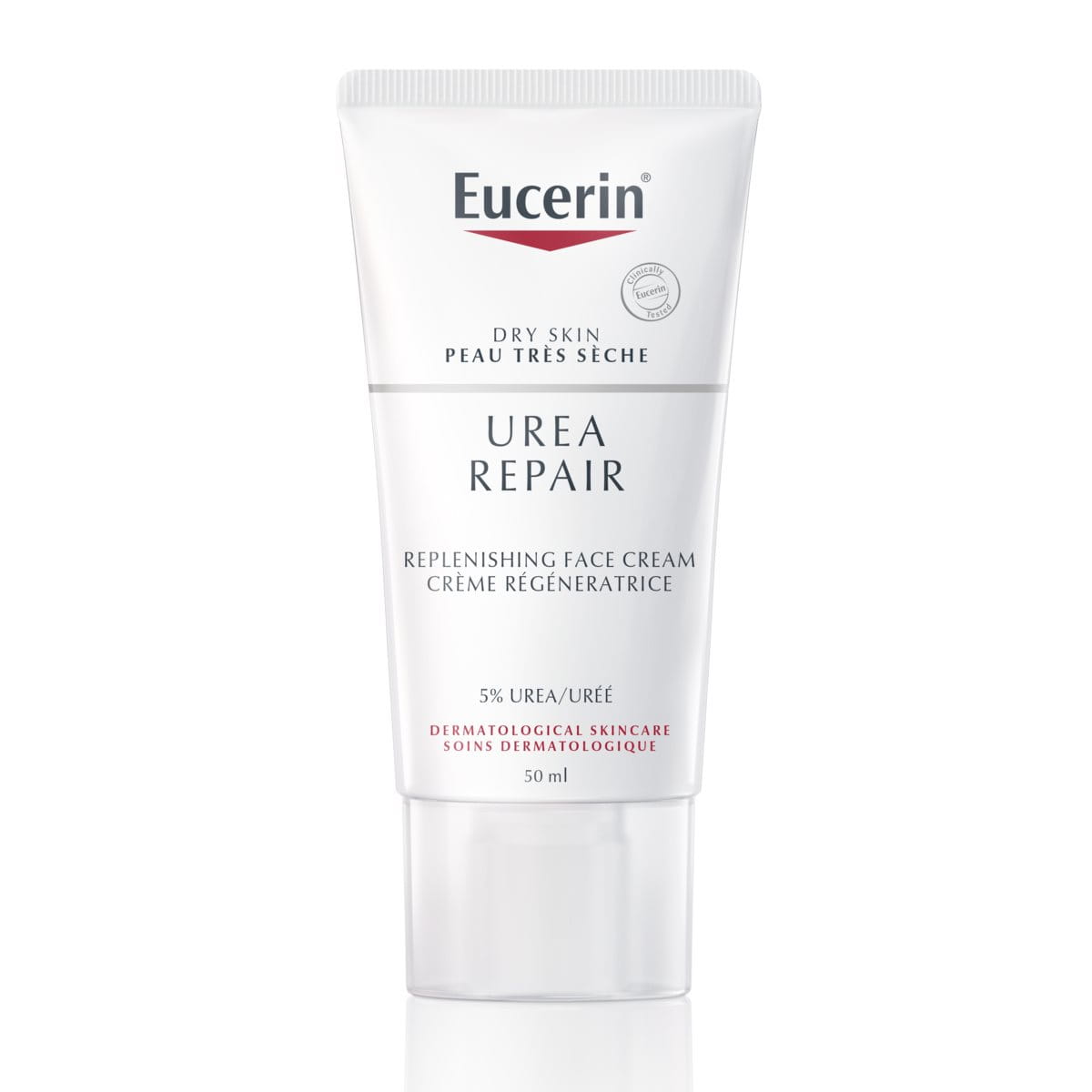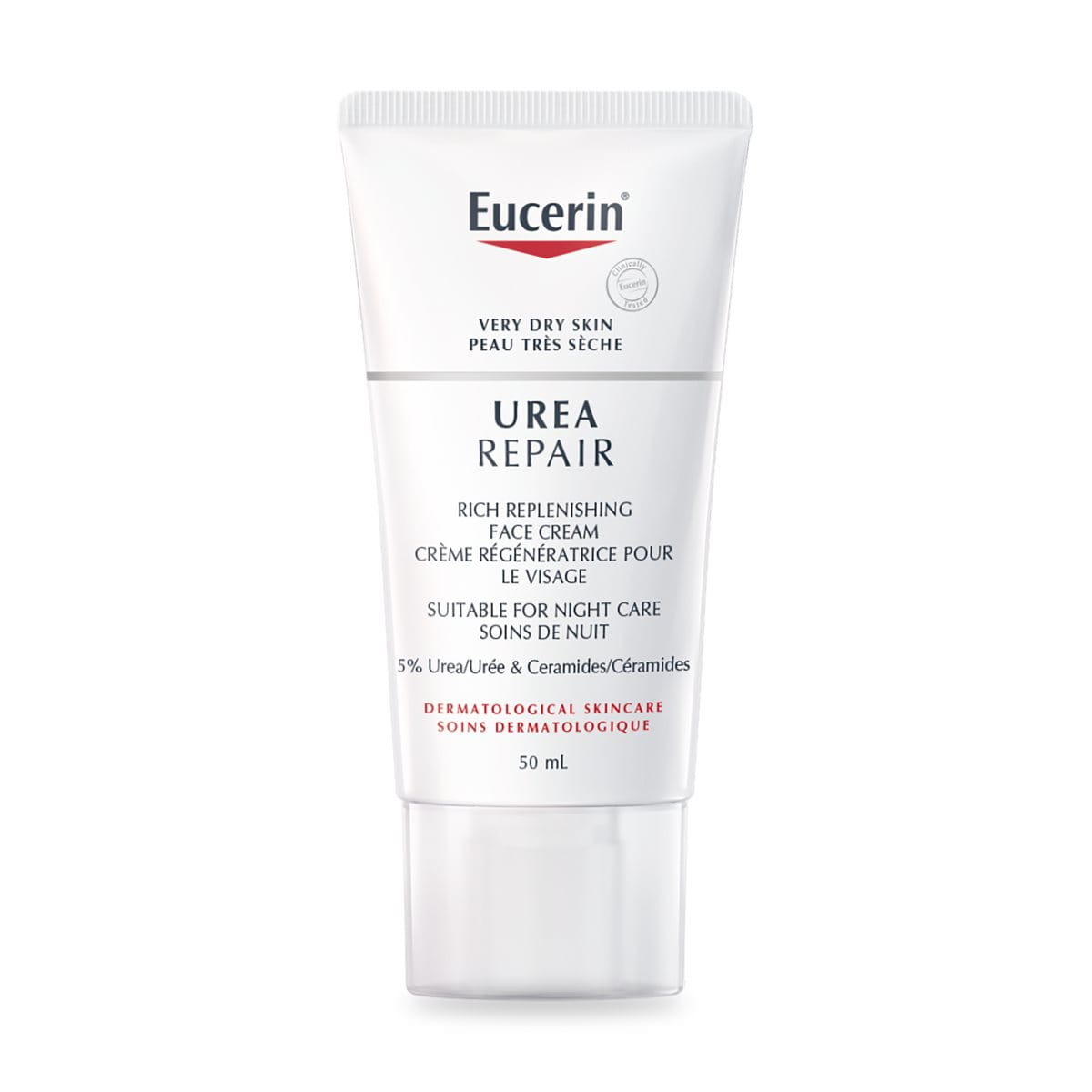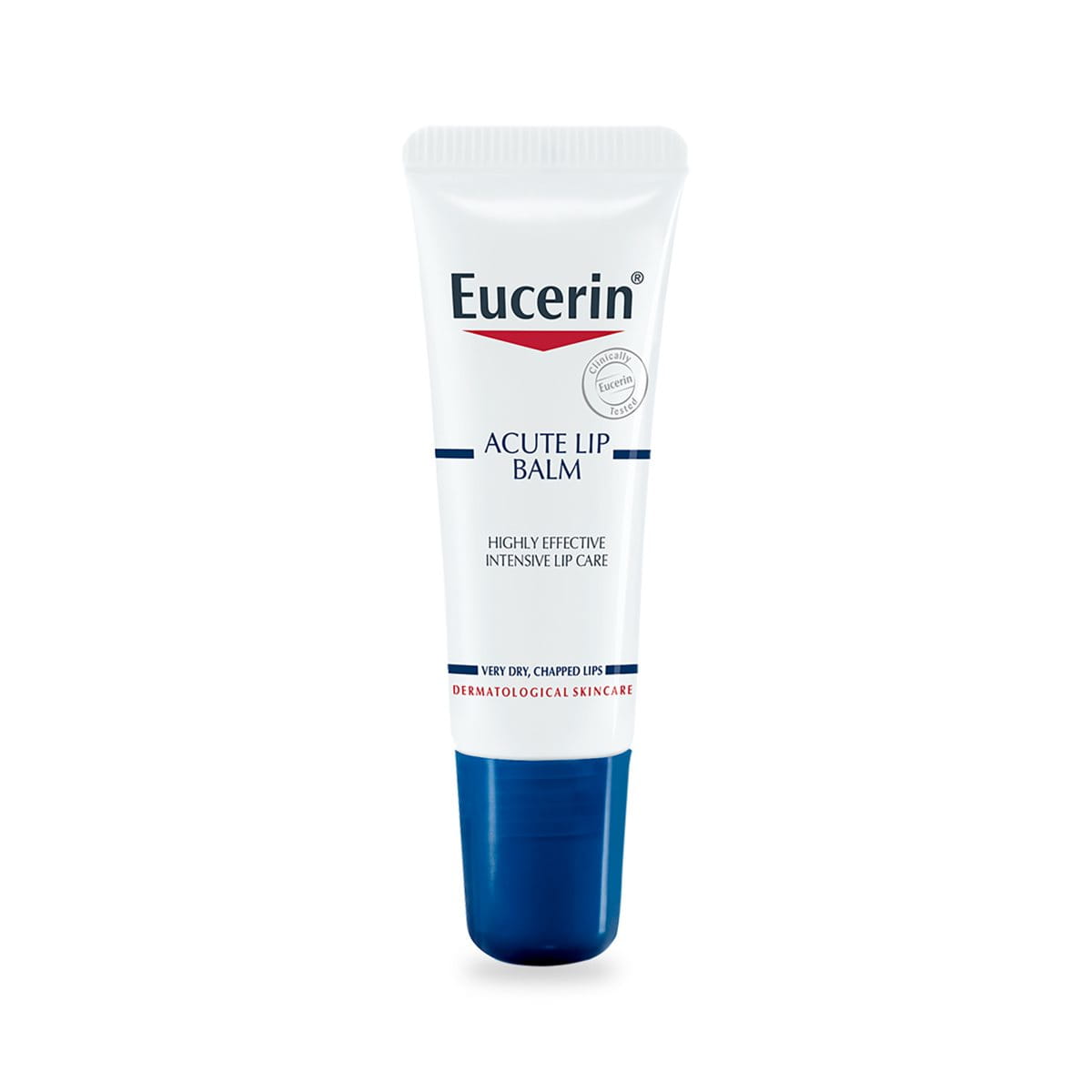Flaky skin on the face can be difficult to hide. Our facial skin is one of our most important body parts, but when it becomes dry it can feel rough and tight, even reddened, scaly and itchy. This then appears flaky or bumpy, making your complexion susceptible to other issues like sensitivity and redness. Covering this up with make-up can worsen the issue. Explore the causes of dry skin on the face and what treatments are available to help you get rid of dry skin on the face.
Signs & Symptoms
Skin dryness and facial skin types
Dry facial skin is a common condition, although some people are more prone to it than others depending on your skin type. The main facial skin types are:
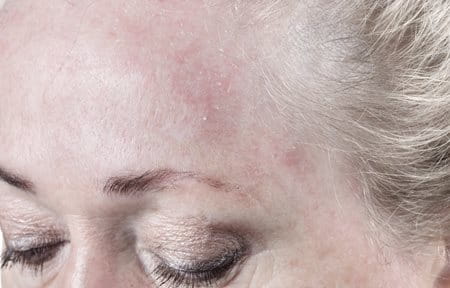
- Normal type facial skin refers to skin that is neither prone to dryness nor oiliness. Many factors can cause normal facial skin to become dry, explained below under ‘What causes dry skin on face’.
- Dry type facial skin is facial skin that has a tendency to be dry and typically feels tight and slightly rough in some areas.
- Oily type facial skin is less likely to become dry, except in the case of excessive washing, or following a poor skincare routine.
- Combination type facial skin tends to develop dryness in certain areas of the face, particularly on the cheeks, whereas the forehead or T-zone is oily.
Symptoms of dry facial skin
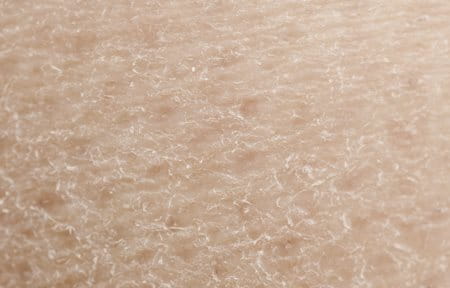
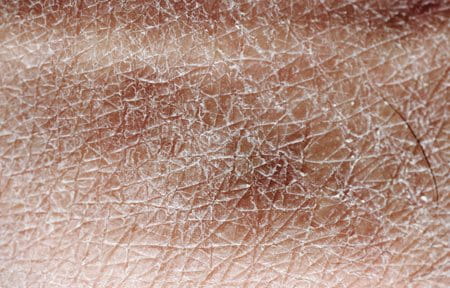
When dry patches on the face first become noticeable, the skin will feel dehydrated and tight which will worsen if left untreated, developing into flaky skin that can be red and sore. Dehydrated skin lacks water and appears dull or rough. It is not unusual for dry skin to only affect specific areas of the face, with many sufferers experiencing dry skin around the nose, mouth and forehead.
The T-zone is the area of your face that covers the forehead and the top of the nose, which are also the areas most prone to showing initial symptoms of dry facial skin conditions. Dry skin on the face is commonly noticed in this zone during the winter seasons as the t-zone is very prone to dryness and flaky skin conditions.
Dry skin on the faceWhen facial skin first begins to lose moisture, the dryness may be only noticed as:
- Tightness
- Roughness
If this initial facial dryness is not treated, it can progress to become:
- Very tight
- Scaly
- Flaky
- Chapped
- Itchy
- Redness
At this stage, it is possible that dryness-induced fine lines will develop, and this contributes to premature skin ageing and wrinkle formation. This can also lead to the appearance of symptoms, such as peeling and bleeding. Those with darker skin tones may notice an ashy, grey-looking skin. Extremely dry facial skin can be mistaken for psoriasis on the face.
When the face becomes dry, the skin will often also be sensitive; however, sensitive facial skin is not always related to dryness. With both dry and sensitive skin, it is always important to avoid skincare products that contain irritating ingredients, such as perfumes and colourants. Always check that any skincare product you intend to use has been dermatologically tested on sensitive skin.
Dry facial skin, skin conditions & diseases
- Xerosis is the medical term for dry skin, and is experienced by most people at one point in their lives. The term comes from Greek; ‘Xero’, means ‘dry’, and ‘osis’ means ‘disease’. Find out more about xerosis here.
- Inflammatory skin conditions, such as atopic dermatitis and psoriasis, are also linked to facial dryness
- Hyperthyroidism is a condition where your body does not create enough thyroid hormones which can lead to dry and peeling skin
- Metabolic conditions, such as diabetes mellitus and kidney diseases, can also increase the risk of dry skin on the face developing
- Some acne medications, either topical or oral, can cause oily, acne-prone skin to become extremely dry
Dry skin around eyes
Itchy, flaky and dry skin around the eyes, including under the eyes and on the eyelids, can be caused by a range of factors. The symptoms of dry skin around the eyes will differ depending on the severity and the cause of the dry skin.
There is further information on dry skin, including tips on preventing dry skin in our full dry skin guide, as well as information on other skin conditions, such as atopic dermatitis, psoriasis and diabetes mellitus, throughout our website. But if you are worried or unsure about your symptoms, or they are becoming worse, we recommend that you see your doctor or dermatologist for a face-to-face diagnosis.
When to seek medical advice about dry skin on your face
If you need further information to help you identify the cause of your skin complaint, and which treatment route to take, the skin test may be a useful diagnostic tool.
What causes dry skin on face?
There are many internal and external causes of dry, flaky facial skin, all of which contribute to the same skin dehydration process. The severity of the dry facial skin will depend on the number and intensity of these factors.
External triggers of dry facial skin
The main external triggers of dry skin on the face are environmental triggers and inappropriate facial skincare routines. The face is generally exposed to these external causes of dry skin much more frequently than the rest of your body, hence causing dry patches on the face to form:

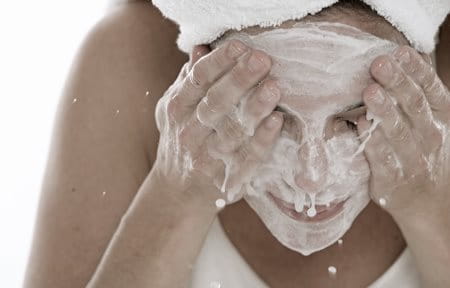
Environmental
- Harsh weather conditions – hot, cold and dry air
- Seasonal changes – dry skin symptoms are more common in the winter and summer months
- Ultraviolet (UV) sunlight can increase the rate of skin ageing, and the skin becomes more prone to dryness as it ages
- Chlorine – dry skin can occur after coming into contact with chlorine in a swimming pool
Skincare
- Frequent washing, or long, hot baths and showers, removes many of the lipids that make up the skin barrier.
- Inappropriate facial skincare routine – it is important to follow a routine and use products that are suitable for dry skin, avoiding strong soaps that strip away natural skin lipids. Discover our expert-recommended routine for dry skin on the face.
Medication
Some medications have the side effect of changing the water balance within the skin. Medications that control blood pressure, or diuretics, are known to have this side effect. Always check with a doctor or pharmacist if you are concerned that a medication may be contributing to dry skin.
How external triggers can cause dry facial skin


All of the external triggers of dry facial skin cause the skin's natural lipid surface barrier to deteriorate. Once this lipid barrier is broken, moisture can evaporate from the skin, and the vital moisture-binding substances are easily washed out.
As these natural moisturising mechanisms decline, the skin is not able to hold as much water and becomes dry until the moisture-binding substances are replenished, and the lipid barrier on the surface is repaired.
If the dry skin is not treated with tailored skincare products which contain moisturising factors, the dryness can progress deeper into the facial skin and disrupt moisture networks in the deeper layers of the skin. As a result, the natural upward flow of moisture into the upper layers is reduced, resulting in severely dry skin.
Internal factors that can cause dry skin
Genetic influences
Every person has a unique set of genes which determine skin characteristics like pigmentation, moisture and lipid levels. This means that, under identical conditions, different people will have different moisture and lipid levels in their skin. Fair-skinned individuals are more likely to develop dry skin than people with darker complexions. Additionally, diseases such as Atopic Dermatitis, Psoriasis, diabetes and ichthyosis often have a genetic link.


Hormonal influences
When the level of our hormones change, for instance during pregnancy, adolescence and the menopause, the skin’s moisture balance can be affected. Dry skin on the face during pregnancy is common. Also, the amount of oestrogen in the body is reduced during the menopause, which can result in the skin becoming dryer. Learn more about dry skin and pregnancy.
AgeThe skin’s ability to produce sweat and lipids decreases as we get older. This is due to a decline in the functioning of sebaceous and sweat glands in the skin. Increasing age leaves the skin more prone to dryness, and the drier the skin, the more prone it is to the formation of fine lines and wrinkles. You can learn more about age-induced dryness here.
UV light
Skin ageing occurs naturally with increasing age. However, extensive and unprotected exposure to ultraviolet (UV) light can increase the rate of skin-ageing, thus leading to premature fine lines and wrinkles. Avoiding excessive sun exposure and protecting your skin from UV damage can prevent premature skin aging.
Diet
Skin requires a range of nutrients, unsaturated fatty acids and vitamins in order to function correctly. A lack of any of these can contribute to dry skin. Eating a healthy, balanced diet can help to keep the skin functioning normally.
Contributing factors to dry skin on face
Factors contributing to dry facial skin
In addition to the main causes of dry facial skin, several other factors also affect the severity of facial skin dryness. An awareness of these will help you avoid them and thereby reduce their impact.
Lack of effective treatment
If dry facial skin is not treated properly, or ineffective moisturisers are used, the dry skin condition is likely to become worse rather than improve. This is because the dryness progresses, affecting the moisture networks in the deeper layers of the skin. As these networks supply moisture to the upper layers of the skin, if they become compromised the skin dryness will continue to worsen.


Sun exposure
Excessive sun exposure may increase facial skin dryness. It is therefore important to choose a sunscreen that is formulated for dry skin, which contains moisturising ingredients in addition to an appropriate Sun Protection Factor (SPF).
It is also vital that the sunscreen, and any other skincare products used on dry skin, does not contain any irritating perfumes and colourants: dry skin, especially dry facial skin, is more prone to irritation than normal skin.
Occupational hazards
Certain situations or jobs involve exposure to conditions that may cause dry facial skin, e.g. outdoor sports, gardening, holidays in cold areas. By avoiding outdoor and occupational irritants and using adequate skin care products you can combat facial dryness caused by these factors.
Dehydration
The amount of moisture in the skin is related to the amount of water that the body can supply. When the body is dehydrated, therefore, it is unable to supply adequate amounts of water to the skin, leading to dry skin developing.
People who are prone to dehydration include the elderly, as the sensation of thirst declines with age, as well as manual labourers and those who exercise regularly. Learn more about dehydrated skin.
Smoking
The toxins in cigarette smoke, including nicotine, may reduce the blood flow. This results in a slower metabolism within the skin, causing skin to dry out and age prematurely. Tobacco can cause irritation to your lips. Learn more about dry, cracked lips here.
Solutions
How to treat dry skin on the face
Solutions to dry facial skin
In addition to having a good cleansing and moisturising skincare routine, avoiding factors that contribute to dry skin is important in preventing and treating dry facial skin. This will help to reduce the impact of dry skin and the need for long-term treatment:
- Reduce the time spent in hot water by having quick showers between 5-10 minutes, instead of long baths. It's best to use warm, not hot, water when bathing or washing the face to avoid stripping the skin of its natural oils. Apply a gentle and moisturising cleanser and remember to use moisturiser after bathing. Pat dry your skin instead of rubbing it dry. Avoid showering or bathing more than once a day if possible.
- Avoid dry air by spending less time outdoors in hot and cold weather, and by using a humidifier indoors when the heating is on. Dry air, both hot and cold in temperature, can dry the skin out. Air conditioning and central heating units indoors also remove moisture from the air and thus the skin. By spending less time outdoors in dry air conditions such as during cold winter days and low humidity, as well as using a humidifier indoors, can all help to lessen the effects of dry air on the skin.
- Wear warm clothing outside to ensure you're protecting your skin from cold air. Use a scarf around your neck to stay warm, but try and avoid fabrics that feel scratchy and rough.
- Use care products without perfumes, colourants and parabens to avoid irritation. Dry, and especially dry, sensitive skin, is prone to irritation from these ingredients so it is always best to use skin care products that have been dermatologically tested on dry & sensitive skin. Your washing detergent should be hypoallergenic and fragrance-free.
Dry and very dry skin on the face needs a comprehensive skincare routine to be adequately treated and replenish moisture levels. This includes using appropriate skin cleansers, moisturisers and sunscreens. Water-based skin cleansers with added moisturising factors are suitable for dry to very dry facial skin, while oil-based cleansers are ideally suited for the care of very dry and extremely dry skin, including Atopic Dermatitis.
Dry facial skin symptoms can be eased with a week of changing your bathing or skincare routine. These changes must become part of your daily routine to ensure consistent and significant results.
Face moisturiser for dry skin

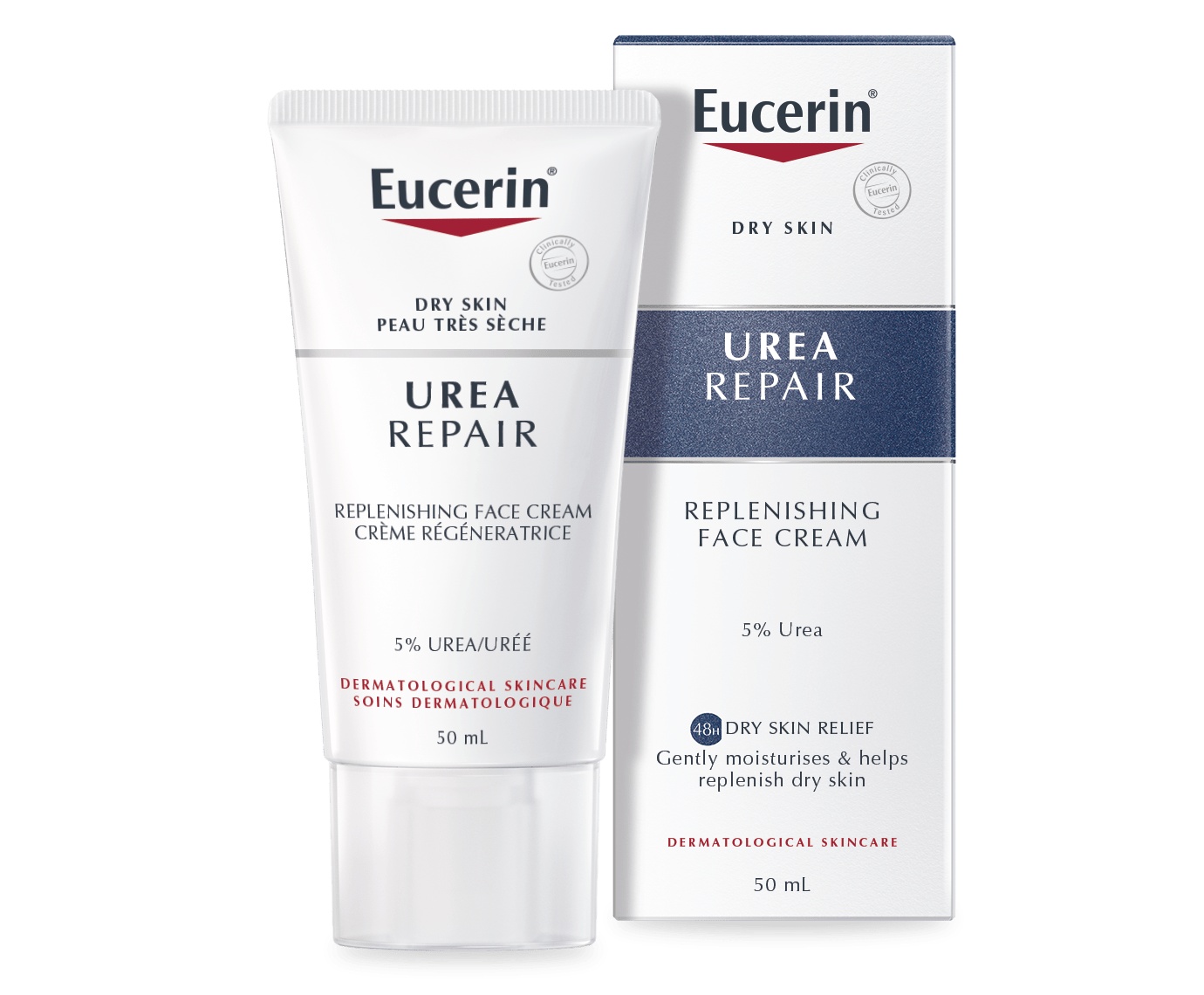
Moisturisers and creams replenish missing natural moisturising factors, which attract moisture towards, and bind moisture into the stratum corneum (the upper layer of the skin). This prevents the skin from becoming dry, and reduces roughness and alleviates tightness.
To ensure that your skin retains moisture, look for skincare products that contain the following ingredients:
- Urea
- Lactate
- Polyethylene glycol
- Akyl-polyglycoside
- Lanolin
- Paraffin
Eucerin Urea Repair Face Cream is a gentle everyday moisturiser for dry to very dry skin. This light face cream contains the natural moisturising factors Urea and Lactate which regulate moisture content by binding water in the upper layers of the skin to replenish dry facial skin. Both Urea and Lactate are well-tolerated, non-toxic and non-allergenic natural skin compounds that can be used on dry, very dry and sensitive facial skin. Apply a moisturiser before bed before washing the face with a gentle cleanser the following morning.
Gentle cleanser for dry facial skin


If your skin feels dry and tight after washing it, you may be using the wrong cleanser for your skin. Products containing colours, fragrances or other chemicals can irritate our skin.
A mild but effective skin cleanser is an essential prerequisite to skincare for normal or dry skin, as well as for acne-prone skin and Atopic Dermatitis.
The importance of a well-aligned daily cleansing and moisturising routine for face care cannot be overemphasised: facial skin with a functioning surface barrier absorbs and retains moisture effectively.
The Eucerin DermatoCLEAN Mild Cleansing Milk is designed for dry and sensitive facial skin with moisturising ingredients to cleanse the skin, preventing it from drying out. Mild enough for sensitive skin, it also synergistically enhances the efficacy of facial moisturising creams to improve the hydration of the skin. Use with Eucerin DermatoCLEAN Clarifying Toner to instantly tone and moisturise the skin, suitable for all facial skin types.
How often you should wash your face if you have dry skin
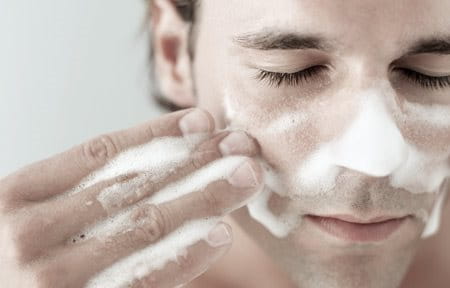
Washing dry facial skin too often can lead to dryness and irritation becoming worse. Although for most skin types washing your face twice a day (morning and night) is sufficient to remove the build up of dirt on the skin, washing dry skin once a day can be enough to keep the skin clean without drying it out further.
However, you should always properly clean your skin after wearing makeup, and if you have exercised or your skin has become sweaty. By using a gentle, hydrating cleanser formulated to clean and simultaneously nourish dry skin, such as Eucerin DermatoCLEAN Mild Cleansing Milk, you can prevent facial dryness progressing while still washing your face without irritation.
Exfoliating dry skin on face
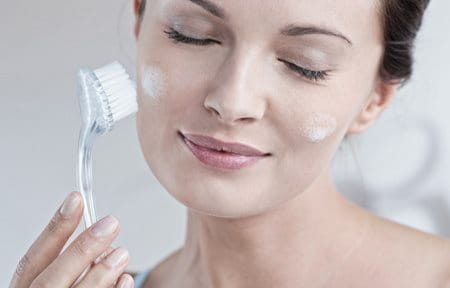
Exfoliating our skin helps to remove dead skin cells, in turn reducing dry patches and smoothening skin's overall texture. Dry brushing brushing is the process of using a dry brush against your skin to help remove dead cells from the skin’s surface. Although dry brushing is an effective way to exfoliate your skin, brushing too aggressively or too often can cause damage to the skin, causing or worsening pre-existing irritation and dryness. Because of this, dry brushing is not recommended for those with sensitive skin, or dry skin conditions such as Atopic Dermatitis (eczema), Psoriasis and Keratosis Pilaris (also known as chicken skin).
Dry skin sufferers should test a new exfoliator on a small area of their face before using it all over. Avoid exfoliating every day though, and apply a moisturiser immediately after to lock in moisture. Learn more about how to exfoliate.
Is steaming your face good for dry skin?

Steaming your face using hot water is a common step in many skin care routines at home. Although steaming your face is relaxing and is believed to help in treating some skin conditions such as acne, the heat from the steam can worsen dry facial skin. Exposing your skin to hot steam can lead to flushing and increased inflammation, worsening conditions such as Rosacea. The hot steam can also strip your skin of its natural moisturising factors, causing increased dehydration and dryness.
Caring for dry, ageing skin
Caring for ageing skin requires addressing the common causes of skin ageing. As the skin ages, skin dryness and UV damage contribute to the development of fine lines and wrinkles and the loss of skin volume, density and radiance. This makes following an effective skincare routine, especially moisturising and protecting skin against UVA and UVB light, even more important. Additionally, ageing skin often requires deep skin hydration to reduce the appearance of, and prevent the further development of, further wrinkles. You can learn more about age-induced dryness here.

Hyaluron is found naturally in the skin, and has high water-binding capacities, as well as improving skin regeneration and enhancing the diffusion of nutrients. As facial skin ages, the amount of free Hyaluron decreases in the epidermis, particularly in the lower dermis skin layers. Hyaluronic Acid, applied topically, can slow down and reverse wrinkle formation. The benefits of applying hyaluronic acid to the skin can be further enhanced by a suitable moisturising skincare routine.
Our brand values

We deliver a holistic dermo-cosmetic approach to protect your skin, keep it healthy and radiant.

We work together with leading dermatologist and pharmacist partners around the world to create innovative and effective skincare products they can trust and recommend.

For over 100 years, we have dedicated ourselves to researching and innovating in the field of skin science. We believe in creating active ingredients and soothing formulas with high tolerability that work to help you live your life better each day.
